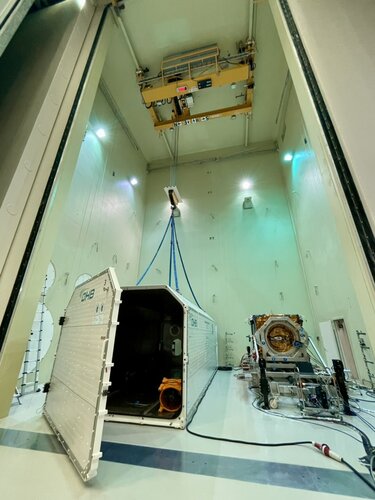
Copernical Team
Spire Global Secures CA 1.41 Million Canadian Government Contract for Ship Tracking
 Spire Global, Inc. (NYSE: SPIR), a leader in space-based data, analytics, and space services, has been awarded a CA $1.41 million contract by the Government of Canada (GoC) to provide global automatic identification system (AIS) ship tracking data. The one-year agreement includes options for two additional years, potentially increasing the total value to nearly CA $4.23 million.
"We are pr
Spire Global, Inc. (NYSE: SPIR), a leader in space-based data, analytics, and space services, has been awarded a CA $1.41 million contract by the Government of Canada (GoC) to provide global automatic identification system (AIS) ship tracking data. The one-year agreement includes options for two additional years, potentially increasing the total value to nearly CA $4.23 million.
"We are pr Hera in the doghouse
 Image:
Hera in the doghouse
Image:
Hera in the doghouse Spectacular Red Sprites Captured from the ISS
NextNav Receives DOT Award to Enhance PNT Services as GPS Backup
 NextNav (Nasdaq: NN), a leader in advanced positioning, navigation, timing (PNT), and 3D geolocation, has announced receiving a new award from the U.S. Department of Transportation (U.S. DOT). This award will support real-world field tests of NextNav's 3D PNT technologies, designed to provide critical infrastructure with reliable PNT information when GPS is unavailable or compromised due to envi
NextNav (Nasdaq: NN), a leader in advanced positioning, navigation, timing (PNT), and 3D geolocation, has announced receiving a new award from the U.S. Department of Transportation (U.S. DOT). This award will support real-world field tests of NextNav's 3D PNT technologies, designed to provide critical infrastructure with reliable PNT information when GPS is unavailable or compromised due to envi NASA CubeSat Joins ESA's Ariane 6 Maiden Flight as Rideshare Payload
 NASA has successfully launched the CURIE (CubeSat Radio Interferometry Experiment) as a rideshare payload on the European Space Agency's (ESA) first Ariane 6 rocket. The launch took place at 4 p.m. GFT on July 9 at the Guiana Space Center in Kourou, French Guiana.
The CURIE mission, designed by a team from the University of California, Berkeley, aims to utilize radio interferometry to inve
NASA has successfully launched the CURIE (CubeSat Radio Interferometry Experiment) as a rideshare payload on the European Space Agency's (ESA) first Ariane 6 rocket. The launch took place at 4 p.m. GFT on July 9 at the Guiana Space Center in Kourou, French Guiana.
The CURIE mission, designed by a team from the University of California, Berkeley, aims to utilize radio interferometry to inve Maritime Satellite Communications Market Expands with Rising NGSO Solutions
 The maritime satellite communication market saw substantial growth in 2023, largely due to Starlink's entry into the market with its maritime service, which has quickly gained popularity and increased the number of VSAT-equipped vessels.
The latest report from Novaspace, a merger of Euroconsult and SpaceTec Partners, titled Prospects for Maritime Satellite Communications, indicates a signi
The maritime satellite communication market saw substantial growth in 2023, largely due to Starlink's entry into the market with its maritime service, which has quickly gained popularity and increased the number of VSAT-equipped vessels.
The latest report from Novaspace, a merger of Euroconsult and SpaceTec Partners, titled Prospects for Maritime Satellite Communications, indicates a signi Hubble Identifies Potential Intermediate-Mass Black Hole in Omega Centauri
 An international team of astronomers has analyzed over 500 images from the NASA/ESA Hubble Space Telescope, spanning two decades, to identify seven rapidly moving stars in the core of Omega Centauri, the largest and brightest globular cluster visible in the sky. These stars offer significant evidence suggesting the presence of an intermediate-mass black hole (IMBH).
Intermediate-mass black
An international team of astronomers has analyzed over 500 images from the NASA/ESA Hubble Space Telescope, spanning two decades, to identify seven rapidly moving stars in the core of Omega Centauri, the largest and brightest globular cluster visible in the sky. These stars offer significant evidence suggesting the presence of an intermediate-mass black hole (IMBH).
Intermediate-mass black Astronomers spot mysteriously elusive mid-sized black hole
 Astronomers said on Wednesday they have found the strongest evidence yet of a medium-sized black hole, the strange absence of which has been one of the enduring mysteries of the cosmos.
The universe is riddled with black holes, from supermassive ones at the heart of galaxies to smaller ones around 100 times the mass of the Sun.
But scientists have struggled to find black holes between t
Astronomers said on Wednesday they have found the strongest evidence yet of a medium-sized black hole, the strange absence of which has been one of the enduring mysteries of the cosmos.
The universe is riddled with black holes, from supermassive ones at the heart of galaxies to smaller ones around 100 times the mass of the Sun.
But scientists have struggled to find black holes between t Dark Comets May Constitute a Major Portion of Near-Earth Objects
 Up to 60% of near-Earth objects (NEOs) might be dark comets, according to new research from the University of Michigan. These dark comets, which likely contain or once contained ice, may have played a role in delivering water to Earth.
The study, led by Aster Taylor, a graduate student in astronomy at the University of Michigan, suggests that asteroids in the asteroid belt-located between
Up to 60% of near-Earth objects (NEOs) might be dark comets, according to new research from the University of Michigan. These dark comets, which likely contain or once contained ice, may have played a role in delivering water to Earth.
The study, led by Aster Taylor, a graduate student in astronomy at the University of Michigan, suggests that asteroids in the asteroid belt-located between Mars Likely Experienced Cold and Icy Conditions, Study Suggests
 The question of whether Mars ever supported life has fascinated scientists and the public for decades. Central to this inquiry is understanding the planet's past climate: was it warm and wet, akin to Earth's climate, or was it cold and icy, making it less likely to support life as we know it? A recent study points to the latter, drawing parallels between Martian soils and those found in the suba
The question of whether Mars ever supported life has fascinated scientists and the public for decades. Central to this inquiry is understanding the planet's past climate: was it warm and wet, akin to Earth's climate, or was it cold and icy, making it less likely to support life as we know it? A recent study points to the latter, drawing parallels between Martian soils and those found in the suba 































